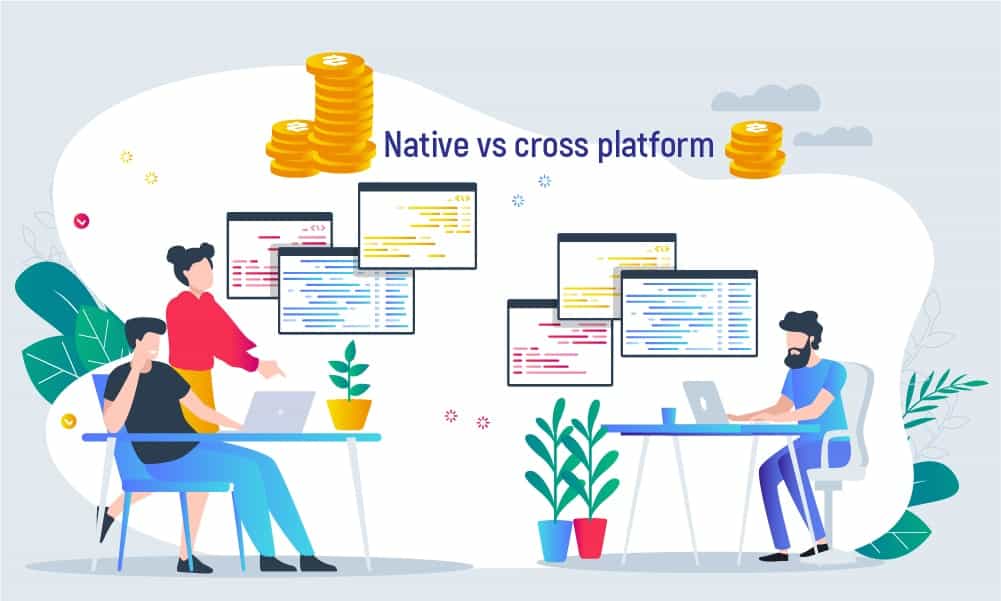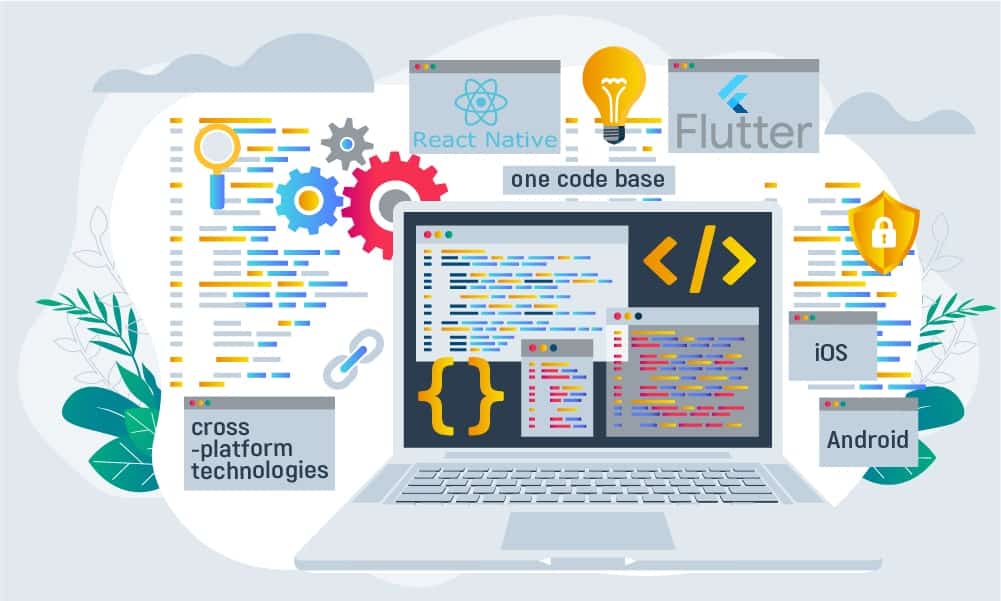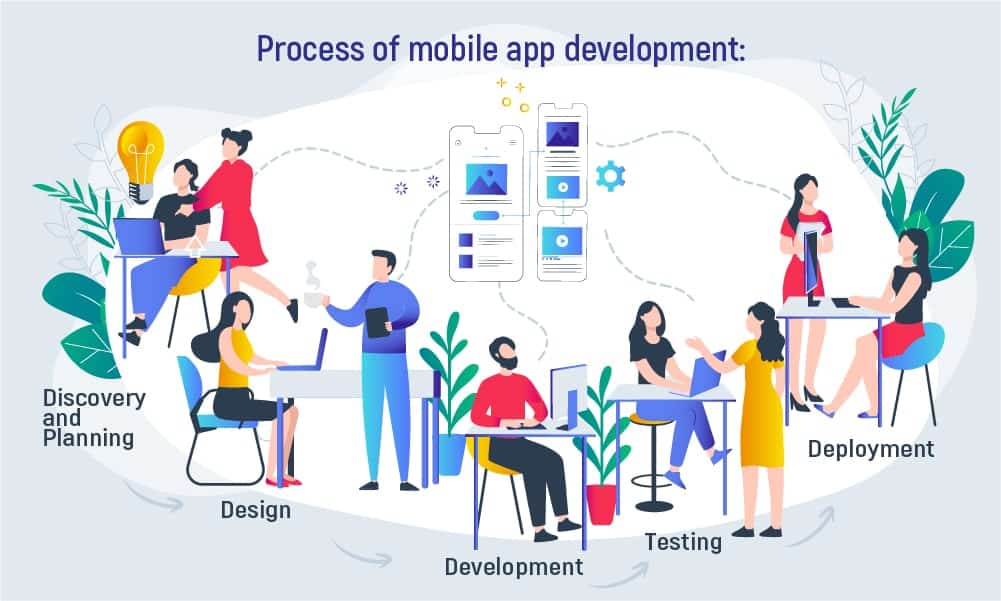In the article, we are going to assess the benefits and challenges of both native and cross-platform development. Also, get to know the key metrics for mobile apps!
- Native App vs Cross-Platform: Market Demand
- Cross-platform and Native Applications Explained
- Difference Between Cross-Platform and Native App Development
- Performance and Speed
- Development Time
- Development Costs
- Security
- Customization
- Native vs Cross-Platform App Development: Cost Comparison
- Best Cross-Platform Technologies
- What to Consider When Choosing an Approach to Build a Mobile App?
- Breakdown of Mobile App Development Process Components
- Discovery Phase
- Planning
- Design
- Development
- Testing
- Deployment
- Consider Inoxoft Your Trusted Mobile App Development Partner
- Final Thoughts
Native App vs Cross-Platform: Market Demand
According to PRNewswire, 34% of small businesses have a mobile app, and 42% plan to develop a mobile app in the future. Mobile app development offers valuable opportunities for a business: going digital and competitive, showing a presence on the market, attracting more customers, and so on. Choosing a mobile app development approach turns out to be challenging. If you are a business in need of building Android and iOS apps, what approach – native or cross-platform application development – should you choose and why?
Android maintained its position as the leading mobile operating system worldwide in the fourth quarter of 2023 with a market share of 70.1 percent. Android’s closest rival, Apple’s iOS, had a market share of 29.2 percent during the same period. The most popular cross-platform mobile frameworks used by developers across the world were Flutter and, only then, React Native.
Cross-platform and Native Applications Explained
What is cross-platform meant for? Firstly, for building iOS and Android mobile apps simultaneously with a significant reduction in costs and development time. Secondly, cross-platform app development pushes your application to iOS and Android app markets which increases the chances of obtaining more users and, thus more customers.
Native applications are developed for a particular operating system or device. Hence, software development differentiates Native Android from Native iOS approaches as both take different technologies to build mobile solutions. Native Android developers will use Java and Kotlin as the core of their app. iOS engineers will use Swift and Objective-C. So, outlining key benefits of cross-platform vs native development:
- Cross-platform apps have better time to market capabilities
- Cross-platform apps are usually cheaper to develop because of hiring one developer instead of two engineers – one for iOS, one for Android
- Cross-platform takes less time for development and testing
- Native app development offers higher performance
- Native applications have access to 100% of Android and iOS hardware
- Engineers face fewer challenges in developing Android or ios custom functional features
HD games and complex animation apps are better be native as they will get access to local files and hardware and will perform faster and smoother. It takes more time to build a native app but you’ll never have to worry about the quality and user experience though.
Difference Between Cross-Platform and Native App Development
What are the major differences between native and cross-platform apps? Let’s compare native and cross-platform core development features:
Performance and Speed
When it comes to performance, native app development is a winner. With a native app platform, it is possible to use various smartphone features. This is great when you need to optimize service delivery but enhance the performance of your app. Phones have lots of cool features these days.
Development Time
The process of development will be faster if to consider multi-platform solutions. These will require less effort than native ones. Besides, the process to market the native apps leads to a launch on an app store. You will have to download the app before using it. And, there’s a huge competition and strict rules of how this can be done.
Development Costs
If you have an extensive budget you can build a native app. But, in the long run, a cross-platform one will be cheaper. And nonetheless functional. Cross-platform apps require a single source code. You can later transform it into an Android or iOS-powered app if you want to.>
Security
Here, native apps win again. The in-built security features these apps use help them be protected. Also, these features allow developers to encrypt files, detect fraud and ensure 100% security easier. If the thing is in the budget, consider a cross-platform app. You will make it a native one later.
Customization
Native apps seem to be better when it comes to customization and user expectations. They have a better UI with pre-set libraries and interface components.
Native vs Cross-Platform App Development: Cost Comparison
The cost of mobile app development depends on the complexity of the project features. The budget will depend on what team you hire, and whether or not you’ll have QA engineers or Business Analysts. A simple app that is MVP with a minimum list of features and compatibility with only 1 platform can be built in about 2-4 months. Medium apps will be implemented for 1-2 platforms having more complex designs and more features. Large-scale apps will include custom functionality, support for different platforms, perfectly executed design, scalable architecture, and more.
- Simple social media applications can cost from $10 – 20 000
- Medium complexity social media app starts at $35 000 and the cost for a cross-platform one starts at $30 000
The minimum price for developing native Android or iOS applications of simple complexity is approximately $35k. The price can go as high as many features you need to develop. That’s why building native apps can be pretty expensive, especially if you want to develop iOS and Android mobile solutions at the same time. If you can not predict costs at the beginning of the project, it’s always better to talk with a digital expert who can estimate costs and help you be aware of the final price of the product.
The starting price for a medium cross-platform app would be about $30k. Price also depends on the software provider’s location. What’s the top mobile app development company in the USA? Hiring US engineers will be more expensive as the hourly rate there is higher than in Western Europe or Eastern Europe. Ukraine provides technology expertise that is very competitive with Americans. Being the biggest country in Europe, the Ukrainian talent pool is enormous. Lviv, Kyiv, and Kharkiv software companies provide high-quality cross-platform and native application development for US clients as well as for clients all across the world.
Best Cross-Platform Technologies
Flutter is a cross-platform Software Development Kit that was powered by Google to create beautiful UI. The technology is killing React Native as it offers fast and easy development. Flutter apps feel native, but cost less to develop and maintain. Some of the defining features of Flutter are:
- Engineers develop iOS and Android apps from a single code base
- Flutter is based on Dart known for fast compilation of code (just-in-time compilation) and V8 engine
- Flutter is primarily created for building mesmerizing and smooth complex animations. Flutter documentation provides clear and finely explained instructions on implementing a variety of animations as well as delivering custom ones.
React Native is an older cross-platform technology than Flutter, but offers reliable code, building functional features of any complexity at a high quality and fast performance. In comparison to Flutter, React Native engineers will have to develop, maintain, and update separate code bases for different platforms.
What to Consider When Choosing an Approach to Build a Mobile App?
Depending on what business needs are put into focus, the technology for your mobile app can differ. If it is performance and speed that you consider critical for your application, then you should think about building a native application development.
If you want to get a market-ready application quickly and there are not too many custom functional features difficult to implement, then you should better choose cross-platform application development with Flutter or React Native. They both offer optimal performance, excellent UI, and fast development time. What’s more, find your perfect mobile app monetization strategy!
Breakdown of Mobile App Development Process Components
Discovery Phase
The software development projects typically start with a discovery phase which is a research of end-users and market trends that result in refined requirements, clarifying business needs, risk evaluation, estimation of costs, and time for development. Factors that influence how much time a team and a client spend on research are the industry specifics, the client’s understanding of software development, and awareness of the end-clients pain points.
The Discovery phase is a low-cost service that proves to be highly beneficial for product owners as it helps avoid the risks of building the wrong solution. Even here, native vs cross-platform mobile app development will have their differences. The discovery of a native solution will take more time and will be more costly.
Planning
The scope of the project is the next stage after research. The team can plan the project activities based on the data they’ve collected and analyzed. Project plans will be documented together with all requirements, design wireframes, timeframes, and costs. It’s important to ensure both parties are on the same page to avoid misunderstandings in the future over the product functionality and project budget. So, native vs cross platform app development will have different project complexity and, this way, have the non-similar plans for their creation.
Choose Inoxoft custom mobile application development services! Benefit from the right choice!
Design
Both cross-platform vs native mobile development will consist of the following steps. These steps highly depend on the project complexity (small, medium, or large), the client’s timeframes, and the budget involved.
1. Wireframing. Wireframes are the skeleton of the application. These simplest design screens show layout and application structure. The average time spent on software wireframing ranges from 14 to 56 hours for small and medium-size projects and 140 hours for large-scale projects. To note, the price also depends on the number of screens.
2. Visual design can take from 14 to 80 hours. On large projects, designers can spend up to 210 hours. Visual design is for implementing colors, images, and fonts to reflect the brand identity and add visual attractiveness.
3. UI/UX mockups are the final stage of design development that can take from 7 to 28 hours of developer’s time for a small-medium app, and up to 200 for large applications. Mock-ups which are clickable design screens and a final version of the app structure are transferred to software engineers and testers during development.
Development
Functional features, complexity, and number vary from project to project. Native app development involves simpler solutions as there is the direct interaction of the app with the device’s hardware. Features of the highest cost are usually:
- Wireframing, visual, and UI/UX design
- Integrations with enterprise data
- CMS development
- Back-end development for platform’s scalability
Solutions like social media integrations, chatting, push notifications, and emails often need third-party integrations and more time to develop, thus more costs to spend. The same is true with user login functionality. API-driven login systems are costlier than device-based login not backed by the server. Which design screen should show login details and what it will look like, whether should there be a login via Google account, whether should there be two-step authentication, and many other questions that finally influence the cost of the mobile application.
Data storage solutions are easier to develop for only device storage. Offline and online access to data and dataset complexity can significantly influence the price of the application. Data encryption and access to enterprise data depend on the different scenarios, like the amount of data, how data is accessed, how big is data storage, and so on.
Analytics and performance monitoring is critical for understanding users’ interaction with the app, monitoring ROI, customer engagement, etc. A Content Management System allows to control and manage content and often needs to be implemented on the web in a customized way that suits an organization’s structure and goals. Web platform helps businesses manage users’ accounts, import and export data, and manage permissions for different user roles.
The realization of custom user interfaces and specific modules that interact with each other can increase the cost of both native apps vs cross-platform apps.
Need an app developer? Find out the mobile app developer hourly rate!
Testing
Quality assurance services upgrade the reliability of the solutions and eliminate all doubts concerning code stability, performance, UI/UX bugs, etc. The more time required for development, the more time will be spent on testing the mobile app respectively. Cross-platform apps vs native apps depend on the different levels of feature complexity that will influence the time needed for the testing.
Deployment
Deployment of cross-platform vs native applications is easier. Native iOS and Android engineers have to be aware of all regulations established by Apple and Google to successfully deploy to the market. The time of deployment depends on the configuration of the application but as a rule, it does not require a lot of time. Besides, cross-platform application development allows easier and faster updating of the codebase simultaneously for different platforms. It has cross-platform frameworks to use. Such an advantage is offered by Flutter.
Learn more about the 7 application development phases!
Consider Inoxoft Your Trusted Mobile App Development Partner
Inoxoft is a cross-platform vs native app development company with lots of smart minds on our mobile team. We know the mobile app development platforms comparison and can determine which mobile app will suit your business needs the most – native or cross-platform.
Interested in cross-platform mobile development vs native cost? If you want to know the average price for your native iOS, Android, or cross-platform application, you can use the App Cost Calculator. Or, talk with our digital experts and receive in-depth business analysis and an estimate of mobile app native vs cross-platform development costs.
Contact us if you are hesitating about which mobile technology to choose. With our precise explanations, you will be able to differentiate between native app development vs cross-platform. Let’s build great solutions together!
Final Thoughts
To conclude, this article is a full comparison of native and cross-platform app development approaches. Inoxoft has assessed the benefits and challenges of both approaches and has listed the key metrics for mobile apps. Consider your business needs and goals first and then choose which app development method is optimal for you.
Frequently Asked Questions
What is the difference between cross-platform and native app development?
- Cross-platform technology is for building iOS and Android mobile apps simultaneously with a significant reduction in costs and development time.
- Cross-platform app development pushes your application to iOS and Android app markets which increases the chances to obtain more users.
- Native applications are developed for a particular operating system or device. Native Android and Native iOS approaches take different technologies to build mobile solutions.
- Native Android developers will use Java and Kotlin as the core of their app. iOS engineers will use Swift and Objective-C.
What impacts native apps vs cross-platform apps costs?
If you want to know the average price for your native iOS, Android, or cross-platform application, you can use the App Cost Calculator. Or consult Inoxoft experts. The actual cost will depend on your requirements.
What to consider in native vs cross-platform app development?
Depending on what business needs are put into focus, the technology for your mobile app can differ. If it is performance and speed that you consider critical for your application, then you should think about building a native application development. If it is time and budget - then build a cross-platform solution.











